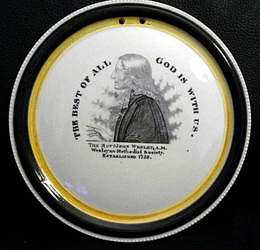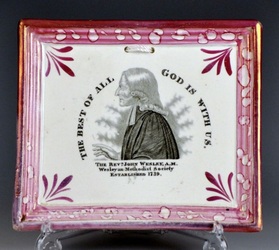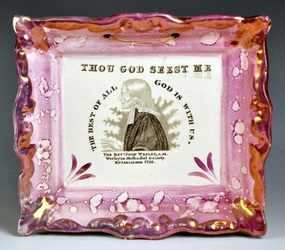|
12/17/2010 0 Comments The 'Dixon' WesleyA plaque currently listed on eBay got me thinking. The circular form, and black and yellow borders, are generally associated with the earlier years of transfer-printed plaque production (1820–1840). See the plaque dates page for an overview. But the transfer itself is worn and degraded – in this case lacking a nose. In fact, of the 5 or 6 plaques I've seen of this kind (e.g. below left photo), all of them have been pretty worn looking. There are several transfers based on the Edridge portrait, with subtle variations. I'm going to stick my neck out and attribute this one to the Dixon & Co partnerships in Sunderland. So what are its defining features? Unlike the Edridge portrait, the Wesleys on plaques tend to be surrounded by what I can only describe as an 'aura' – a kind of divine force field radiating out from Wesley in prongs. The defining feature of the Dixon transfer (below left) is that to the right of Wesley there are 6 prongs, whereas on other Wesley transfers there are only 5 prongs. (Note also that the plaque below right has an extra line of script, 'FOUNDER OF THE', in the title.) The Dixon transfer, unlike the others, has a full stop after the word 'Society'. Small rectangular plaques with three 'feathers' in each corner, like the one below left, are known to exist with the Dixon, Phillips and Co, surrounding anchor, impressed mark. This one is unmarked. The transfer is identical to the one above it, though crisper in definition. Note the added banner 'THOU GOD SEEST ME'. This feature, which also appears on Clarke plaques, is unique (as far as I know) to Dixon. The below right plaque is a variation of the non-Dixon plaque above it. It has a 5-pronged aura, but lacks the words 'FOUNDER OF THE' in the title. Neither of the next two plaques was made by Dixon. They are both of later forms with wide borders. The plaque on the left does, however, have the 'Dixon' Wesley transfer with 6 prongs. The plaque is attributed to John Carr's Low Lights Pottery in North Shields. It seems likely, therefore, that it post dates 1865 when the Garrison Pottery (Dixon & partners) closed. The copper transfer plates were sold to other potteries in that year. The Carr pottery also produced Masonic plaques with the two columns (see emblems and armorials) more usually associated with Dixon. It is likely that Carr had the plates re-engraved to restore clarity. The below right plaque, from an as yet unidentified pottery, appears to have the same transfer as the small plaque above it. The final two plaques are both Dixon. The left has the Dixon, Phillips and Co, surrounding anchor, impressed mark. My research suggests a date range of 1834–1850 for this mark. The right plaque is later, I suggest 1851–1865, and has the impressed mark Dixon Co. Plaques exist with and without the 'THOU GOD SEEST ME' banner, for both impressed marks. By looking at the degradation of the transfer of the circular black and yellow plaque, and comparing it with the plaques above, it should be possible to date it. My guess would be 1840s, or perhaps even 50s, which is later than I'd previously supposed. |
AuthorStephen Smith lives in London, and is always happy to hear from other collectors. If you have an interesting collection of plaques, and are based in the UK, he will photograph them for you. Free advice given regarding selling and dispersal of a collection, or to those wishing to start one. Just get in touch... Archives
February 2022
AcknowledgementsThis website is indebted to collectors, dealers and enthusiasts who have shared their knowledge or photos. In particular: Ian Holmes, Stephen Duckworth, Dick Henrywood, Norman Lowe, Keith Lovell, Donald H Ryan, Harold Crowder, Jack and Joyce Cockerill, Myrna Schkolne, Elinor Penna, Ian Sharp, Shauna Gregg at the Sunderland Museum, Keith Bell, Martyn Edgell, and Liz Denton.
|









